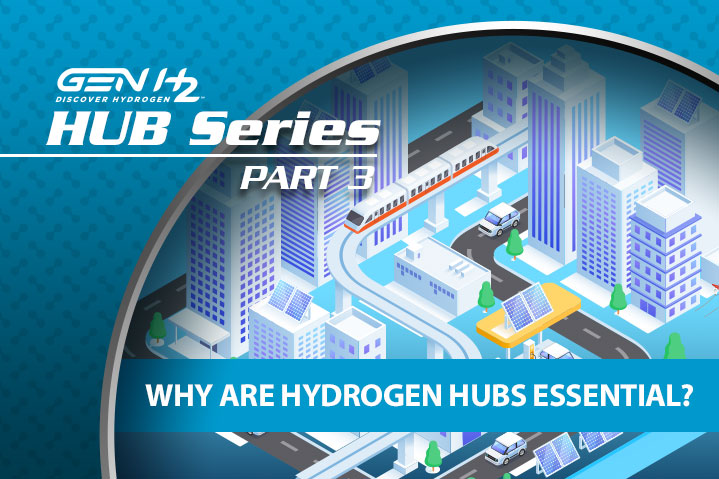Hub Series: Part 3
By: GenH2 Staff
Read Time: 3 minutes
Why Are Hydrogen Hubs Essential?
In the last installment of our Hub Series, we discussed what a Hydrogen Hub is: an infrastructure network located in close proximity which integrates a number of hydrogen-based energy services that connect hydrogen producers and consumers. In the Infrastructure Investment and Jobs Act (IIJA), the U.S. Congress authorized the creation of Regional Clean Hydrogen Hubs (H2Hubs) to meet a range of needs and drive progress in this emerging industry. Each regional clean hydrogen hub will produce clean hydrogen from multiple energy resources, encourage diverse end uses of hydrogen, create training/employment opportunities, and cover targeted regions of the United States. These hubs represent a starting point and nexus for the proliferation of hydrogen as an energy vector for both transportation and electrical power.
The H2Hubs program aims to establish centralized locations and plays an essential role in providing “a network of clean hydrogen producers, potential clean hydrogen consumers, and the connective infrastructure” to demonstrate use cases for the production, processing, storage, transportation, and use of clean hydrogen as the energy carrier for the future.
Of additional interest and benefit, the legislation also calls for H2Hubs to be a pathway of economic growth and investment in the regions where the hubs are located. Beyond the formal requirements for technical demonstration, the only other instruction from Congress is that the U.S. Department of Energy (DOE) “shall give priority to regional clean hydrogen hubs that are likely to create opportunities for skills training and long-term employment to the greatest number of residents in the region.” The DOE has highlighted how the economic goals of the program are part of the vision of the IIJA and enhancing U.S. competitiveness in the world, creating good jobs, and ensuring stronger access to these economic benefits for underserved communities are a big part of President Biden’s agenda.
This is encouraging news, especially for the United States’ hydrogen energy industry. The number of countries with policies that directly support investment in hydrogen technologies is increasing, along with the number of sectors they target. In fact, the Center for Strategic and International Studies (CSIS) Energy Security and Climate Change Program has hosted several workshops to explore how best practices in regional economic development and innovation policy could help inform the design and administration of H2Hubs. The program also considered how hub models are being used around the world to foster investments in clean-hydrogen production, create market demand for it, and reported that interest in planning clean hydrogen pathways to net-zero goals is leading to growing investment interest around the world. According to a global market analysis report, the hydrogen generation market was USD 129.85 billion in 2021 and is expected to expand at a compound annual growth rate (CAGR) of 6.4% from 2022 to 2030.
GenH2 is one of those companies encouraged by the growing hydrogen energy industry news and already making major strides in the hydrogen energy industry moving forward, especially in the use of liquid hydrogen. GenH2 capabilities in liquid hydrogen liquefaction, controlled storage, and transfer solutions provide an infrastructure backbone and interconnectivity for the developing hubs in the future and is a pathway to support the hydrogen ecosystem while meeting net-zero goals. GenH2’s approach to modular systems and zero boil-off controlled, active refrigeration systems can meet future Hubs needs, while currently providing innovative solutions for current marketplace demands.



